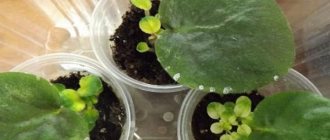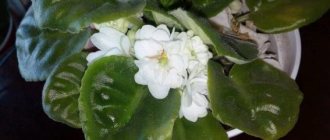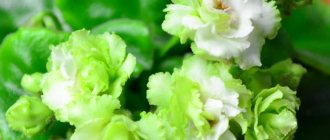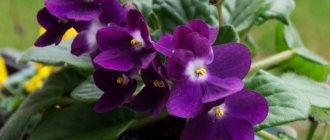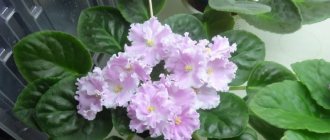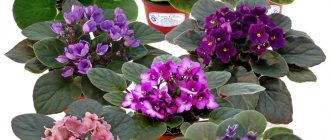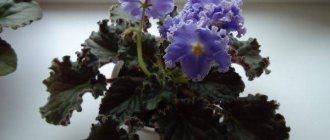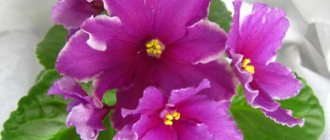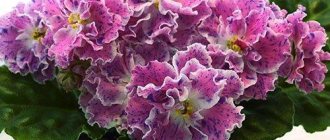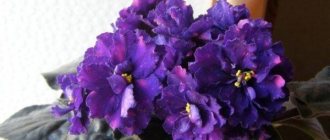This violet is ideal for people who do not have time to care for indoor plants. The plant has beautiful semi-double , white flowers.
And if you are a busy person, then a plant such as the Yan Skazka violet should be ideal for you.
This flower has exotic beauty and does not require too much attention. Care at home is not difficult , the plant is suitable for busy people who are limited in time.
Advice! Despite the fact that cultivation and care do not require special skills, it is worth using the rules for lush flowering.
Violet YAN-Fairy Tale (N. Puminova)
Genus, family
Uzambara violet. Belongs to the Gesneriaceae family, genus Saintpaulia hybrida.
Luxurious violet YAN Skazka (N. Puminova).
History of the variety
The Yan-Skazka variety is included in the register of varieties by Puminova N.A. The plant was first discovered in 1892 by Baron Walter von Saint-Paul, military commandant of the Uzambara region of the German region.
The German colony was located in the territory of modern Tanzania and Rwanda. Saint-Paul saw the plants while walking around the area around the colony . He collected the seeds and sent them to his father.
Photo and description of the variety
The inflorescences are half-open, the flowering is abundant. Deciduous cover of dark green color, leaf blades:
- Slightly curled upward;
- They have ribbed edges.
The incomparable advantage of this variety is its ease of care .
For successful cultivation, you should follow the following recommendations. Unlike other indoor plants, violet Jan-Skazka:
- Has no rest period;
- And it requires the same temperature throughout the year.
Important! You can use different pots.
Variegation, imprints
Foliage with variegated edges . This trait is preserved at the cellular level of the uterine specimen.
The leaves of the variety have an unusual color.
Sports
There are frequent cases of sporting, i.e. children do not transmit the characteristics of the mother plant . Such instances are called sports.
When and by whom was this plant discovered?
Saintpaulia was discovered by Baron Walter von Saint-Paul in the highlands of East Africa. But its real discoverer is considered to be the German botanist Hermann Wendland, to whom the baron gave the found specimen. The scientist managed to grow seedlings from Saintpaulia seeds and made them bloom.
Thus, in 1893, a previously unknown species appeared, classified by Wendland in the Gesneriaceae family and recorded as Saintpaulia (Saintpaulia) in honor of the baron's family. The name “Uzambara violet” was also assigned to this plant because of its habitat in nature and the slight external resemblance of the flowers to the inflorescences of violets (Viola).
Botanical description of the plant
Indoor violet (the second name is Saintpaulia) is a herbaceous plant with a fibrous surface underdeveloped root system. The "Yan" variety is represented by many varieties. They are united by a compact leaf rosette from 15 to 40 cm in diameter and large inflorescences 5–7 cm in diameter. The leaf blades, depending on the variety, can be glossy or pubescent.
Leaf color varies from pale green to dark green, with possible variegated patches of yellow or white flowers, as well as a border along the edge of the leaf. The shape of the leaves is round, sometimes with a pointed tip, in most cases with a serrated edge. Inflorescences can be double or semi-double, basket-shaped or star-shaped.
The color of the petals is varied:
- creamy white;
- pink;
- peach;
- salmon;
- fuchsia;
- blue;
- lilac;
- violet.
Did you know? The first violet with double pink inflorescence “Double Pink Cloud” was presented at the AVSA flower exhibition in 1954.
A copy was sold for $ 1000.
Many varieties have petals edged or interspersed with a more saturated shade than the main background. Saintpaulia "Yang" blooms twice a year, flowering duration is 2-4 weeks, in some varieties - up to 6 weeks. The interval between flowering is approximately 2–4 months, so the dormant period of plants is relative and does not require special attention. After flowering, the violet forms a fruit - a round or spindle-shaped seed pod. Small seeds fall out of the capsule, which, when ripe, is destroyed by moisture.
The most popular varieties: description and photo
Below you can see photos and descriptions of wonderful varieties such as: YAN-Pasha, YAN-Zabava, YAN-Skazka and others.
I would like to draw attention to the name of the varieties - they are not complicated, but very succinctly, accurately and succinctly define both the appearance of the violet and even the character of the “heroine”. It is worth paying attention to the most popular collector varieties, which are extremely popular among amateur flower growers.
"YAN-Caprice"
Such a capricious young lady, in a creamy white dress, buried in greenish lace, which lies in beautiful waves along the edge of the petals. It blooms with a cap, a very beautiful rosette. The leaves match the flower - slightly wavy, as if quilted, with white variegation. And if the violet doesn’t bloom, it still looks elegant. This variety grows very slowly, but it blooms for a long time , without requiring much attention, and there are no difficulties in care.
"YAN-Minuet"
Violet seems to be frozen in an ancient French dance, as if she is trying to rise up. So young and graceful, she threw her hands up, striking those around her with her slimness and grace. This variety is very popular among violet lovers.
"YAN–Dressy"
A very popular variety among collectors . This violet is really elegant, like a gypsy. Dark pink wavy bright flowers with whitish-green teeth - bells along the edges - are associated with this temperamental girl. The leaves are round, dark green, with a serrated edge. Violet charges with energy, excellent mood and enthusiasm. A small rosette, the flowers resemble a rich bouquet. Let your soul become festive!
"YAN-Katyusha"
Reminds me of a confused girl in a bright little pink-coral dress. There is no pomp and splendor of flowering, but this makes the violet look so sweet and touching. And the light green leaves emphasize the tenderness, sweetness, and modesty of the young creature.
"YAN-Morozko"
Dazzling whiteness and purity of colors. They resemble terry flakes of white snow on a wonderful winter day. “Frost and sun – a wonderful day!” Violet blooms in layers and luxuriantly, and is unpretentious in care .
"YAN-Sultan"
One of the most popular varieties. He is bright and categorical, without unnecessary frills and bows. He is a ruler, a master, unpredictable and stubborn, this is evidenced by his blue outfit, reminiscent of the folds of an expensive oriental robe with a chic white border. It is rich, buried in the luxury of quilted green leaves, decorated with white variegated leaves along the edges. Blooms profusely, with a lush cap.
"Yan-Glass"
Another very popular variety of violet. “Well, would you call it differently?” - this is how Natalya Alexandrovna comments on the name of her creation. The white variegated leaves of the boats look like a perfectly starched napkin, it emphasizes the solemnity of the occasion, and the double soft pink flowers on the fruit-bearing supports resemble glasses. The flower blooms slowly and impressively, it is in no hurry. Demonstrating his importance and importance, he is serious and focused. Beautiful flower!
"YAN–Romeo"
Violet with a romantic name. The flower is very similar to the Shakespearean hero of the Renaissance - a ruffled shirt, a dark green frock coat. And sky blue is the color of deep morality, peace, enlightenment, holiness. Blooms moderately, blooms with bright and large flowers. Blooms for a long time.
"YAN–Fairy Tale"
This violet is truly magical, it changes as it blooms. When it first blooms, it resembles an elegant white-pink coffee cup; greenish lines appear along the edges of the petals, which gradually turn into magical “feathers”. But isn't it a miracle?
The leaves of the fairy violet grow in the shape of a boat with rather large teeth along the very edge and elegant white and green variegation over the entire surface of the leaf. On frosty December days, you need lighting right next to the glass, and then the violet will give its magic for a long time.
"YAN-Zabava"
The violet resembles a bright sugar candy , coral pink, with a wide cherry-pollinated border. Some pallor of the green foliage sets off the violet's outfit. Such delicious fun at the fair! This violet grows quickly, forms many buds, its flowering continues abundantly and brightly, uplifting the mood and strengthening vitality.
"YAN–Pasha"
Such a variegated violet resembles a lilac-blue fireworks display of stars and fancy comets and constellations. The socket is light green, very convenient and compact. The leaves are quilted and toothed. Abundant and somewhat spreading flowering is associated with an unknown fantastic planet.
"YAN–Madame"
The color of this variety of violet is simply amazing: the voluminous double peach-pink flowers darken at the ends, shading and emphasizing the entire chic appearance of the flower, reminiscent of a very impressive multi-layered bouquet. Dark green foliage fits harmoniously. It blooms for a long time, decorating the house, adding the necessary color.
“YAN–Smile”
Violet flowers look like cups, and the green leaves with teeth resemble a motley tablecloth - a self-assembled flower, a very cozy and warm flower. The large pink spots on each petal whisper so pleasantly, welcomingly and softly: “Turn your gaze on me.” And immediately there is a breath of peace and tranquility, warm tea poured into such elegant cups with pink peas, fragrant jam, such a pink dream that you involuntarily want to smile and relax. The violet grows quite quickly and blooms for a long time, bringing peace and joy to the house.
Violets, domestic varieties
Violets, domestic varieties
–
YAN-Sultan
| The first flowers on a neat young rosette. Bloomed very quickly. | Bright rosette. I threw away a lot of flower stalks. Of the white-blue with finger coloring, I liked it for its compactness | Violet grew a head of flowers |
| Very nice, neat rosette |
Page 1]
Photo albums
- Violets, foreign varieties
- Violets, domestic varieties
- Varieties of Korshunova
- Lebetskaya varieties
- Repkina varieties
- Mini, semi-mini
- Trailer violets
- Chimeras
- Episces
- In the interior, or how we grow
- Daughter's orchids
- Winners and prize-winners of photo exhibitions
© 2011-2016, “Violets in Altai”
Personal website of Tamara Bobina,
Site Map
e-mail:
Website development "Active Design"
Start of breeding work
Saintpaulias were first presented at an international horticultural exhibition in the Belgian town of Ghent. After this, European flower growers began to actively cultivate this beautiful plant, and in 1894 it reached America, which quickly became the world center for the selection of these flowers. In 1898, breeders for the first time obtained varieties of reddish, white, pink and burgundy inflorescences - before that, only flowers with purple and blue colors were known.
These charming plants came to Russia in the middle of the 20th century and were initially grown only in greenhouses. Now in the world there are more than 8 thousand varieties of Saintpaulia of the most diverse colors, sizes and shapes, but every year breeders develop more and more new varieties of these amazing plants.
Caring for a plant at home
Violets are planted in a small pot . The variety is propagated by cuttings into small plastic cups:
- Adult specimens are grown in clay or plastic vessels;
- Before planting, prepare the soil mixture. To do this, you need to mix turf, leaf, coniferous soil and sand in a ratio of 3:2:1:1. You can use a ready-made substrate for Saintpaulia;
- If desired, you can add a baking powder (perlite, sphagnum, vermiculite) to the soil.
Conditions for keeping the variety
A common reason for the growth of this plant to stop is irregular watering . If the top layer of soil is dry, then it's time to water.
In the first time after acquisition it is not advisable to replant ; if the Saintpaulia was grown in peat, the replantation should be carried out immediately.
Proper watering and fertilizing
During the daytime, the plant should receive the maximum amount of sunlight , but it should avoid direct sunlight. And if the plant is grown in winter, then it will need an additional light source.
For Saintpaulia, you need to choose the right watering.
to fertilize the plant not with dry fertilizers , but with liquid ones.
Attention! Fertilizer should be added every sixth watering of a given flower.
Lighting and air temperature, what is better for the plant: heat or coolness?
The variety is quite demanding in terms of light conditions. Continuous lighting should continue for a minimum of fourteen hours each day. Temperature regime for violets:
- The ideal temperature for Saintpaulia is 20-25 degrees Celsius . At temperatures above 30 degrees, the plant becomes lethargic, its growth and development slow down significantly, at temperatures below 15 degrees the plant gradually dies;
- The optimal water temperature for irrigation is the air temperature in the room where the flower grows;
- When the plant begins to form buds, it must be placed in a cool place , otherwise there will be no green streaks on the flowers.
How does air humidity affect a plant?
If the temperature and humidity conditions are not suitable for violets, you can grow new plants from the strongest leaves.
Violet does not tolerate:
- Temperature changes;
- And dry air.
In summer, under no circumstances should a flower be taken outside, because even the smallest draft can harm the plant.
Violets love moist air.
What kind of soil does the plant prefer when growing at home?
In the first days after planting, the plants will need abundant watering. These days, it is advisable to water with warm, settled water with the addition of wood ash.
Soil for violets can be:
- Prepare from: Chernozem;
- Sand;
- And ash.
Methods of propagation of the variety
Growing this flower from seeds cannot be called difficult.
In this matter, the main thing is to strictly follow the planting recommendations and everything will be fine:
- First, thoroughly sift the top layer of soil mixture. Then fill the pots or other containers with it;
- After the above event, the soil must be left alone for some time until it dries completely;
- Then simply pour the grains onto the ground and sprinkle soil on top. After that, water the whole thing generously.
Rules for transplantation, plant rejuvenation
In the first days after transplantation, you need to create a microclimate for the plants using:
- Films;
- Or glass.
Transplanted specimens must be protected from drafts . Saintpaulias are illuminated in the morning and evening for two hours. It is also necessary to rejuvenate old violets.
Saintpaulia needs to be replanted once a year.
Attention! The first fertilizing with complex fertilizer is carried out 15 days after emergence.
Conditions for successful growing at home
In general, the microclimate for Saintpaulia varieties "Yan" is the same for all varieties, with some exceptions.
Accommodation
Most varieties of the “Yan” variety love diffused light; under too bright light, variegation may not appear. In direct sunlight, the leaves dry out and curl.
The exceptions to the rule are the following varieties:
- "Katyusha";
- "Morozko";
- "Fun".
These violets show their varietal characteristics in more saturated light. Flowers should be placed in sunlight for a couple of hours a day. In winter, plants need lighting up to 10–12 hours a day. It is best to use fluorescent lamps. The optimal location would be south-eastern or south-western window sills. It is preferable to keep specimens that prefer dim lighting on racks near the window.
Did you know? The Soviet Latvian writer Anna Sakse, who wrote many children's fairy tales, in particular, “Flower Tales,” believed that violets were capable of making sounds. Only a sincere person with a pure soul can hear them.
Air temperature and humidity
The temperature of keeping Saintpaulia "Yan" is +20...+25 °C. Exceeding the temperature threatens to shorten the flowering period. Also, the border or variegation of the plates may not appear. For the Morozko variety, exceeding +24 °C is critical, while the Skazka variety loves cool temperatures - +18...+21 °C. All varieties of the variety require 50–60% air humidity. To maintain the required values, household humidifiers are used. In hot weather, the pot can be placed on a tray with wet filler, but the bottom of the pot should not be allowed to come into contact with moisture. In winter, the air is humidified using towels soaked in water placed on heating radiators.
Peculiarities
Currently, there are two varieties of violets with the same name “Fairy Tale”. The first is a varietal violet bred by Natalya Puminova, and the second is a plant by breeder Alexey Tarasov. Since these violets have little resemblance in appearance, when purchasing, pay attention to the prefix before the name of the flower. Capital letters before the variety name most often (but not always) indicate the initials of the breeder. Violets bred by Natalya Puminova have the prefix “YAN”, and flowers selected by Alexey Tarasov have the prefix “AB”.
Planting and care
Violets are unpretentious in maintenance. By familiarizing yourself with the rules of their reproduction and the requirements for conditions, you can get a good result. Proper care will allow your plants to bloom for a long time, even twice a season.
Choosing a place for violets and soil composition
When deciding on a site for planting perennial pansies, choose slightly acidic or neutral soil. They will also appreciate the fertile soil on the elevated site. Drainage in the form of sand or gravel is required - let excess water seep in there.
Violas are also demanding of lighting: they love the sun and diffuse lighting. The shade of taller “neighbors” would be appropriate.
Sow in open ground
Viola seed remains viable for 2 years. Then this ability is lost. Violet seeds can be planted directly in open ground during the summer or before winter.
The location is selected as described above. Then the prepared material is planted in depressions of 1-2 cm. The distance is selected 5-10 centimeters, then they can be planted. Next year you will get quite large flowering baskets.
Seedling method
A great way to get new varieties. Seeds are purchased in a specialized store; there is a wide selection of them. These are both simple and double hybrid varieties.
Sowing is done in March in containers with special soil for violets, or with another flower soil.
- Place the seeds in the prepared boxes with soil, deepening them by 0.5-1 centimeters, sprinkle them;
- We water the planting and cover the top with film or glass;
- Place the seedling container on a bright windowsill and periodically ventilate and spray with a spray bottle;
- Shoots will appear in a week or 10 days;
- Then we remove the film and leave it to grow in warm conditions;
- We wait until the seedlings grow up; the number of leaves should be at least 4 - then they can be planted in permanent places.
Seedlings are planted at a distance of 20-30 centimeters as soon as the threat of frost in May has passed.
Propagation by cuttings
Perennial varieties of violets can be propagated using cuttings. To do this, a stem with two leaves is cut off and placed in water to obtain roots. The procedure is carried out in June or July, roots appear in 15-20 days.
Reproduction by dividing the bush
There are varieties of violets with spread-out rhizomes, and these are the ones that can be divided. Even before flowering or in the fall, the bush should be dug up, stems and leaves removed, and divided into parts. Plant the plants in separate containers or open ground.
Watering and fertilizing
As already mentioned, viola reacts negatively to waterlogged soil. Watering should be done moderately in dry weather; spraying is a good measure.
For rich flowering, plantings are periodically fed, 2-3 times per growing season is the best option. Buy any mineral composition for plants and treat your favorite flowers with it.
Trimming
When the heat comes, the stems of violets stretch upward, towering above the bush. If this is not to your liking, you can trim off the protruding flower stalks, making the bush compact. Pruned plants grow back very quickly. To prolong flowering, remove dry baskets.
Diseases of violets
This flower is susceptible to various diseases. The main reasons are waterlogging of the soil, poor lighting and overfeeding with fertilizers.
Violet can be affected by fungus, powdery mildew, leaf spotting, and the appearance of black spots. Treatment with chemicals helps treat many diseases. If the infection is already severe, then the bush should be dug up and destroyed.
If the stem becomes thinner and darker, it is a black leg. It occurs when crops are thickened or humidity is high. When water stagnates, the plant is attacked by slugs.
In summer, pansies make excellent targets for armyworms and violet pearls. Spray the plant with tobacco infusion or insecticides, this will rid it of parasitic insects.
Reviews about violet
Olga. “The variety pleased me. The only drawback is that the flowers fall off too quickly. This may be due to incorrect temperature conditions. I’ll try to fix everything and continue to monitor.”
Natalia. “I didn’t have any problems with the violet, but to be honest I expected that
terryness
will be more pronounced. Also, from my own experience, I want to warn everyone that when the soil is waterlogged, the roots will rot.”
Svetlana. “Almost immediately I encountered
decay
leaf petioles. Apparently this was due to excess water. In all other respects, the variety completely satisfies me.”
Features of flowering varieties in hot and cool conditions
High positive temperatures are a stress factor for the plant. The pot needs to be placed in a slightly shaded place , where there is no direct sunlight, and not near a radiator; the flower does not like dry air. Grows well on northern windows.
Saintpaulias must be shaded from direct sunlight.
What do flower stalks look like?
Peduncles are shortened and compact. The flowers are abundant, simple, blue-blue, slightly folded stars with a wide white border. Flowering cap.
Is it possible to achieve cap flowering from a variety?
For abundant flowering in the form of a cap, you do not need to make any special efforts . The Yan Skazka variety is precisely created for this kind of flowering.
Duration of flowering bud
It usually blooms for 2 months. Peduncles are formed in the leaf axils . Peduncles form only if they have enough light.
Diseases and pests
It is worth mentioning separately about diseases and insects that can attack this crop. The most common cause of parasites is improper growing conditions.
The most common ailments of Saintpaulia "YAN-Caprice" are fungi. These include powdery mildew, fusarium, gray rot, late blight, and rust. Diseases are caused by spraying leaves and low air temperature in the room. The fungus can be distinguished by dark and brown spots on the leaf plate; spores and white coating also form on the leaf.
You can often notice how violet leaves turn yellow and begin to fade. These signs indicate overheating or direct exposure to the sun's rays on the leaves. In this case, it is recommended to place the flower in a cooler and shaded place, and in the future provide diffused lighting for the plant. Also, the cause of unhealthy looking leaves can be the formation of root rot. This disease appears if the culture is overwatered. Another sign of decay is the appearance of mold.
Among the insects that most like to eat Saintpaulia are mites, thrips, aphids, nematodes, scale insects, and whiteflies. Often these insects are visually noticeable; under their negative influence, spots, dots, and cobwebs form on the leaves
To prevent the appearance of pests, it is important to observe the temperature regime, reduce the frequency of watering when the temperature drops, and systematically ventilate the room. To combat insects, the products “Aktellik”, “Intavir”, “Fitoverm” will be effective.
For processing, drugs are diluted in water in the proportions indicated on the package.
You can learn about the characteristics of the variety and the conditions of keeping the YAN-Caprice violet by watching the video below.
Characteristics of the variety “AV-Skazka”
Alexey Tarasov (also known as Fialkovod) is a young but already quite famous Moscow breeder. He has not been engaged in selection for a very long time, but during this time he has developed spectacular varieties of violets, for example, “AV-Polar Bear”, “AV-Crimean Cherry”, “AV-Mexican Jerboa”, “AV-Plyushevaya”, “AV-Natasha” Rostov", "AV-Gypsy Wedding" . Alexey tries to create plants that are unique, varied in flower shape and color, and do not require special care.
Violet "AV-Skazka" was bred by a breeder in 2016. It has a “small standard” size, a neat, strong socket. She has very beautiful semi-double white flowers, the shape of the inflorescence is similar to a pansy. The petals end in spectacular waves and an unusual swamp-crimson border. The leaves of this variety are simple green in color, slightly wavy at the edges.
Violet Sea Wolf
In nature, there are many different types of violets, which differ from each other in leaf shape, color and size. The variety that interests us differs in appearance from others, primarily in the size of the flowers themselves. Large buds can reach eight centimeters in diameter. The dark green leaves are also large in size and beautifully set off the blue color of the flowers. “Sea Wolf” is a violet that was bred by the famous breeder E. Korshunova. It has a lot of beautiful species in its set, and our variety is far from the last place in this list. Experts consider this species to be an exhibition piece due to its beautiful bell-shaped shape and the semi-terry edging of each flower. Moreover, each petal has a net-like pattern, which adds a special charm to the overall appearance of the plant.
